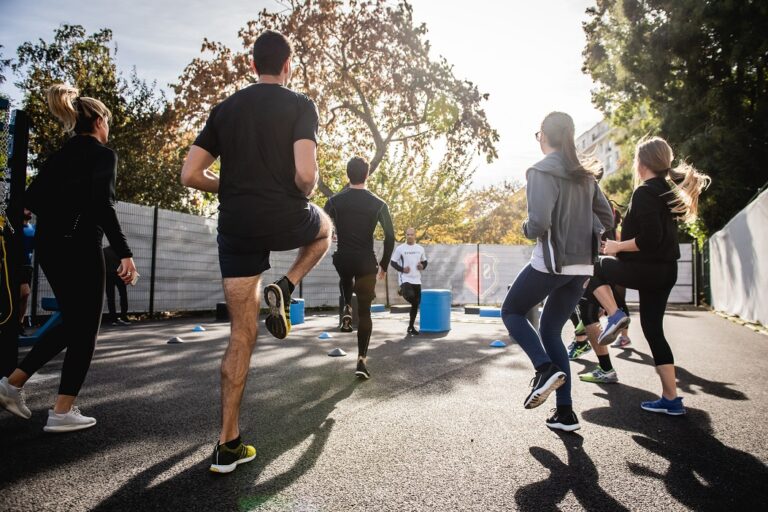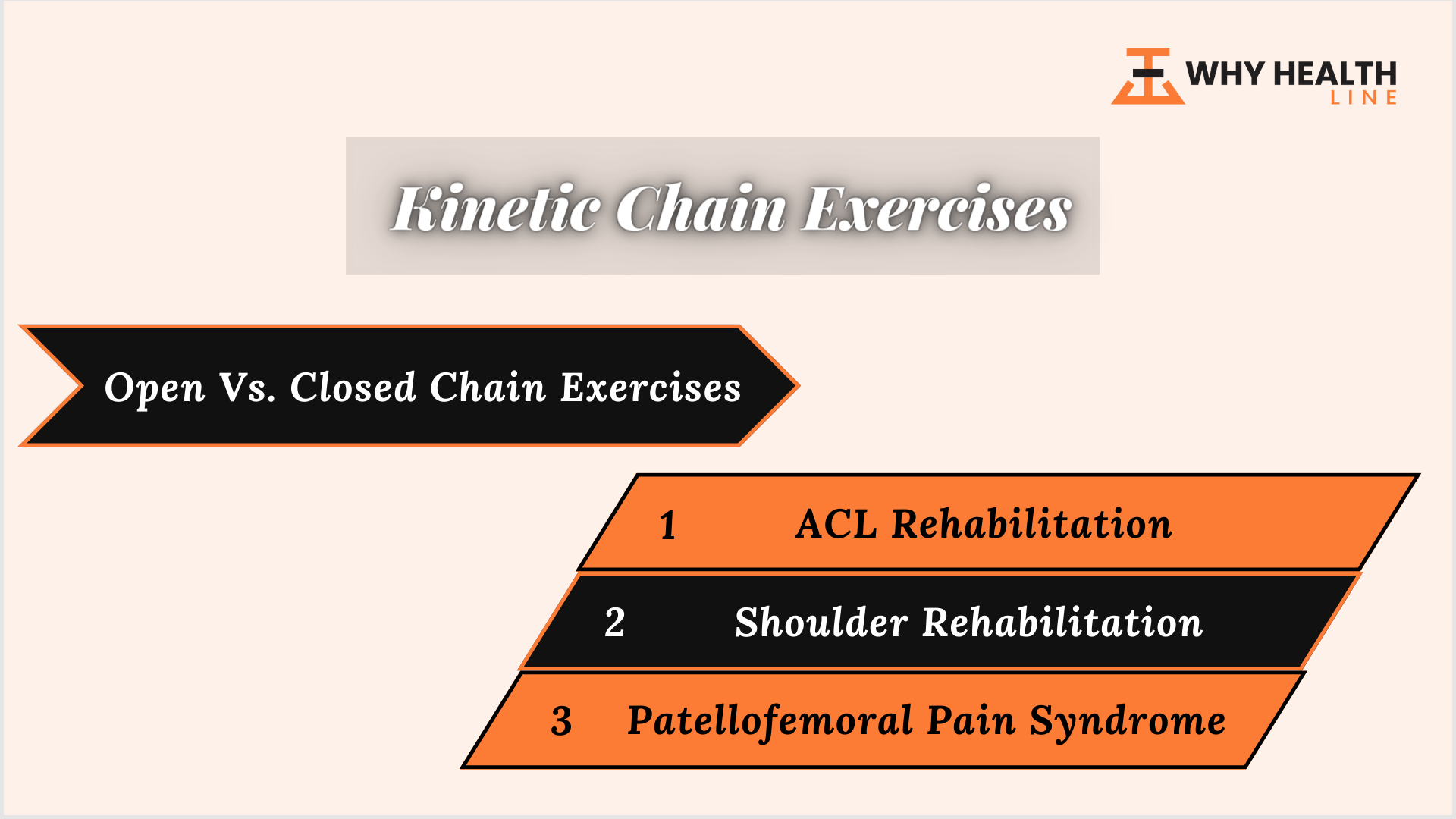
Introduction
The kinetic chain, as it is known anatomically, refers to the interconnected groups of body segments, connecting joints, and muscles that cooperate in carrying out motions, as well as the region of the spine to which they are connected.
The fingers, wrists, forearms,elbows, upper arms, shoulders, shoulder blades, and spinal column form the upper kinetic chain.
The lower kinetic chain comprises the spine, hips, pelvis, lower legs, knees, and toes. Each joint in both chains can individually perform a wide range of movements.
Open Vs. Closed Kinetic Chain Exercise
Closed Chain Exercise
A closed chain is a situation in which the farthest points of the body are fastened to the ground or another substantial item. This locked posture alters the movement of the joints and surrounding musculature up the chain.
As the body drops into the squatting posture, the rest of the leg chain, such as the ankles, knees, and hips, will move toward the fixed end of the extremity, the feet, if the feet are planted firmly on the ground during a squat.
Closed-chain movements have the potential to involve more muscles and joints by supporting joint stabilization.
Closed-chain movements can be applied to numerous everyday motions, which helps improve neuromuscular coordination and overall joint health.
Since many closed-chain exercises teach movement rather than discrete muscle groups and purposefully involve balance and body awareness, they are regarded as “functional” and employed for functional training (proprioception) exercises.
Open Chain Exercise
On the other hand, an open chain describes an action where the distal end of an extremity moves freely in space, such as when doing a seated leg extension on a weight machine or a biceps curl with dumbbells.
In contrast, open-chain motions require more considerable shearing pressures at the implicated joint than closed-chain movements do, and they frequently include just one working joint when doing resistance training exercises like leg extensions and biceps curls.
Single-joint, open-chain exercises isolate and strengthen a specific body component for aesthetic purposes (for example, concentrated hypertrophy in bodybuilding) or enhanced function, such as in pre- or post-habilitative protocols.
In the end, people might benefit the most from multi-joint, closed-chain exercises that concentrate on movement patterns that are transferable to leisure and sport-specific activities.
Open Vs. Closed Chain Exercises in 3 Settings
ACL Rehabilitation
A review showed that open and closed kinetic chain workouts can be employed for post-ACL reconstruction rehabilitation and ACL deficient therapy. The effects of both training modalities on knee discomfort, laxity, and function were incomparable.
Because Open Chain exercises usually result in increased strain, joint laxity, and anterior tibial translation, it is generally accepted that Closed Chain exercises are the best rehabilitation for anterior cruciate ligament (ACL) injuries.
In particular, with complicated movement patterns involving both Open Chain and Closed Chain activities, the reviewers found that using both open and closed-chain exercises proves to be helpful in ACL rehabilitation.
Shoulder Rehabilitation
According to research, closed-chain exercises are superior to open-chain workouts for shoulder rehabilitation for the following reasons:
- They focus on the co-contraction force couples near the shoulder and scapula.
- In these exercises, the rotator cuff is permitted to function as a “compressor cuff.”
Open Chain exercises are usually not considered to be appropriate in shoulder rehabilitation because they produce more shear pressures and require a broader range of motion.
To progress to the open-chain exercises, a stable scapular base and early rotator cuff strength are provided by combining scapular stability exercises with closed-chain workouts. A detailed analysis of the complete kinetic chain is necessary for shoulder rehabilitation.
Patellofemoral Pain Syndrome
Exercises to strengthen the quadriceps treat patellofemoral pain syndrome by strengthening the VMO, reducing lateral patellar tracking, enhancing the neuromuscular system, and enhancing proprioception in the knee joint.
Exercises with an open kinetic chain isolate the quadriceps muscle contraction, whereas exercises with a closed kinetic chain cause both the quadriceps and hamstrings to contract.
Both open and closed kinetic chain exercises reduce discomfort and expand the knee flexion range.

Benefits of Kinetic Chain Exercises
You perform both closed and open kinetic chain movements daily, whether you are climbing up the stairs, standing up from the couch, or picking up a heavy book while sitting at your desk.
That’s why it is important to include both types of exercises in your workout program. The most significant advantage of open-chain exercises is that they are far better at isolating a muscle.
They prove to be extremely useful when rehabilitating a specific muscle or when training for a sport that requires a wide range of muscle movement.
The kinetic chain principle provides a framework for understanding and analyzing human movement patterns as well as the rationale for the utilization of exercise conditioning and rehabilitation programs that emphasize the entire body, despite a target joint.
When one is in motion, these exercises create a chain of events that affect the movement of neighboring joints and segments.
Chiropractors, physical therapists, and personal trainers use kinetic chain exercises to help with recovery, injury prevention, body sculpting, and performance enhancement.
FAQs
What Are The Examples of Closed-chain Exercises?
- Squat
- Wall slide
- Lunge
- Push up
- Pull up
The body moves around the fixed joint in each of the above-mentioned activities because the distal end of the extremity is fixed.
What Are The Examples of Open Kinetic Chain Exercises?
- Seated leg extension
- Leg curl
- Bench press
- Dumbbell biceps curl
- Lat pull down
The distal end of the extremity is not stationary in any of the open-chain kinetic exercises; instead, it moves around the body while the activity is performed.